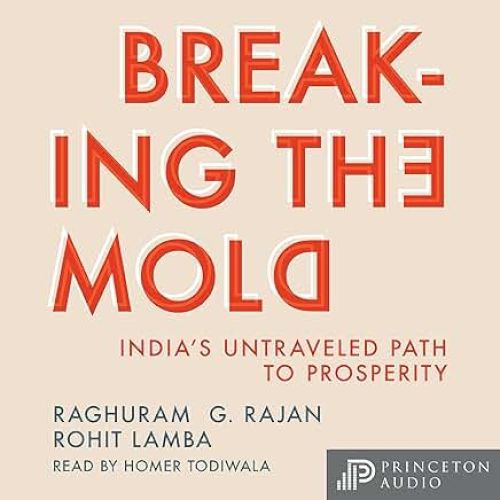03 July 2024
Breaking the Mold
India’s Untravelled Path to Prosperity
Raghuram G.Rajan & Rohit Lamba
2024, Princeton University Press, 298 pages,
ISBN 9780691263632
Reviewer: William A Allen, National Institute for Economic & Social Research

‘Breaking the mold’ is introduced to the reader as a guide to how India can grow and develop further. Raghuram G. Rajan is a former Governor of the Reserve Bank of India and Chief Economist of the IMF, and now a Professor at the Chicago Booth School of Business; Rohit Lamba is an Assistant Professor at New York University Abu Dhabi.
India seems uniquely well-positioned to grow and become more powerful. It has the political stability that democracy provides, and it maintains the rule of law, and by about 2030, it will be the most populous country in the world.
The book is much more wide-ranging than readers might expect from a study of economic growth. For one thing, it is by no means confined to analysis but also includes plenty of exhortation (‘India needs a vision of where it wants to get to’, ‘India must do better’). For another, the choice of growth as a subject gives the authors a licence to talk about more or less any aspect of public policy that they wish to. They take full advantage – for example there are two chapters on education, and single chapters on health care, inequality and foreign policy. So the book amounts almost to a comprehensive political manifesto: an ambitious undertaking for two economists. If the book is a political manifesto, it is clearly a liberal one. It rejects dominance by any religious group and therefore, by implication, the Modi administration – which suffered a serious setback at the polls after the book was written. And it embraces market forces.
It would be impossible for an outsider to provide a well-informed critique of what are in some cases quite detailed policy proposals. Nevertheless, some general comments are in order.
The authors make the important distinction between ‘catching up’ growth and ‘pushing out the frontier’ growth (my names). Catching up growth means adopting production techniques already developed and adopted in other countries. Pushing out the frontier means inventing and adopting completely new technologies. The authors don’t see much promise for India in catching up. China and other low-wage Asian countries have caught up by taking over manufacturing processes from North America, Europe and Japan, and by doing so have narrowed the wage gap. There is now rather limited scope for India to join them, and in any case India’s complicated tariffs and trade restrictions make it very difficult for producers to include India in any multi-national supply chain, in which partly-completed products are transported from country to country during the production and distribution process.
Rajan and Lamba may well be right about this, but for economic liberals, they seem to have a pretty clear idea about where future economic growth will and will not come from. ‘How can India make the next hundred years its “century of flourishing”?’, they ask. Having asked the question, they then go on to attempt an answer, even though by definition it’s impossible to know what will happen once you push out the production frontier.
But, to be fair, any prospective government of any political disposition (which is the position in which Rajan and Lamba put themselves) has to make decisions about all kinds of things, many of which will turn out to be important for economic growth. And Rajan and Lamba make an awful lot of recommendations. Many of them are very sensible: to quote just one example, the government spends five times more on fertiliser subsidies than on higher education; this is obviously a very serious misallocation of resources and the authors are right to recommend re-prioritisation.
Some of the issues are not fully analysed: for example, on equal opportunities the authors say that ‘society delegates to the state the task of creating opportunities for the underprivileged, sometimes by limiting the privileges of others.’ It is clear from the context that the underprivileged are those whose families don’t create many opportunities for them. Most people accept this proposition in general, but the hard question is exactly how much the state should do: how much should it limit some peoples’ privileges, by taxation etc, to create opportunities for those who lack them. The authors make some important recommendations, e.g. redesigning subsidies, but like many other manifestoes, this one ducks the hard question.
As already noted, there is a chapter on foreign policy, despite its rather tenuous connection with economic growth. India’s most important and most difficult relationship is with Pakistan, from which it separated amid so much death and destruction in 1947. This is perhaps India’s greatest weakness, but Rajan and Lamba don’t have much to say about it, except to predict that Pakistan will become easier for India to deal with, and that a dialogue will eventually begin. The summary nature of the discussion is a serious disappointment in a book as ambitious as this one.
The current signs of political change in India make the appearance of this book very timely. The authors are both economists. They stray off-piste in places, but why shouldn’t they? It remains to be seen how persuasive the economists’ manifesto will be. In the meantime, the book is well worth reading for anyone interested in India.
